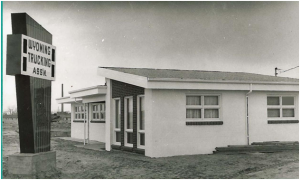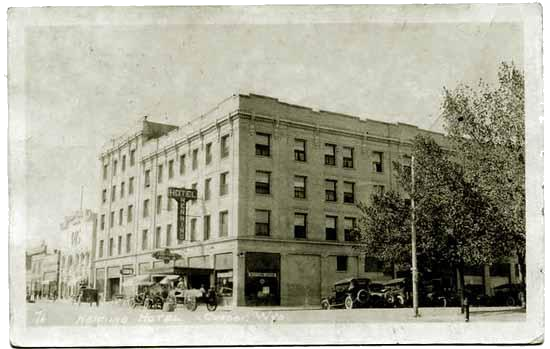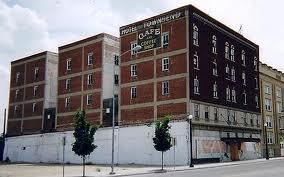History
On July 12, 1939, 26 men interested in highway transportation met at the Henning Hotel in Casper to organize a motor truck association for Wyoming. Chairman of the meeting was Elton Cooley, President of the Motor Truck Common Carriers. Ted V. Rodgers, President of ATA, was present to help the group organize, and spoke on the need for organizations in all the states. It was Earl Buckingham, President of Buckingham Freight Lines, who actually moved that the “Wyoming Motor Truck Association” be organized, with headquarters in Casper, to include all types of carriers.
In the original organization, the Board of Directors was limited to fifteen directors, with five constituting a quorum. Two-thirds of the directors were to be Wyoming residents, one-third, non-resident. William Hilliar was elected the first President, with Tom Weadlick, Vice-President and George Vucurevich, Treasurer. Fred Sims of Casper was the first Secretary-Manager of the Association. The Association started in a small way—the first month, it collected $400.00 in pledges, rented Room 10, Townsend Building, for $25.00 a month, and started operations with a typewriter donated by L.J. Russell. At the second meeting of the Board of Directors, incorporation was approved, a committee to draft by-laws was named, and a dues schedule was set—.50¢ a month per single truck up to 1½ tons and used in city work; .75¢ a month per straight truck using the highways; and $1.00 a month for tractor-semi-trailer combinations.
The young association joined ATA on October 12, 1939. Once organized, the Association grew fast, and included many of the problems the industry faces today in its activities. By the time of the first General Membership Meeting on November 30, 1940, it was an active organization, working in cooperation with ATA, other state associations and highway user groups.
The first two-day convention was held March 13 and 14, 1942. Even then the federal gas tax was an issue even, as evidence by a resolution adopted at that meeting opposing a 100% increase. Another resolution supported a move to amend the Wyoming Constitution to prevent diversion of highway user funds from highway expense. The cooperation of the Association with the war effort was reflected in a resolution to make all facilities of the Wyoming trucking industry available at a moment’s notice to help in the war effort.
The young association was beset by many difficulties – financial, cut rates, 48-foot length for truck and trailer, no license reciprocity, were just a few. At one time the Association nearly passed out of existence due to lack of funds. But then a group from the eleven western states met with a group of both Wyoming and out-of-state operators, and those interested agreed to share a greater part of the cost of operation.
In 1944 the Wyoming Trucking Association became the publishing agent for an interstate oilfield carriers tariff. By 1945, the Association consisted of five conferences (then called divisions); Allied Industries, Freight Carriers, Livestock Carriers, Oilfield Carriers, and Tank Truck Carriers. Later other conferences were added, and the Association now consists of Allied, General, Hazmat, Heavy Specialized, Owner-Operators, Private, Specialized, Bulk conferences in place of the original five.
In 1946, the by-laws were revised to provide for equal representation of each Conference on the Board of Directors, thus increasing the number of that group. Today, including past presidents who have also been added to the Board, and officers, the original 15 has grown to 35. Safety activities were started early, and in 1946 a Certificate of Merit from ATA was earned for WTA’s work in safety. The WTA Council of Safety Supervisors has consistently earned the Summa Cum Laude award from ATA recognizing it’s stellar efforts with safety activities. That year too, a Motor Fleet Supervisors Training Course was held at Casper Junior College, through the cooperation of Penn State University. It wasn’t until 1956, however, that the safety activities were coordinated through the organization of the Wyoming Council of Safety Supervisors. The first training course was held in Casper in the fall of 1960. The Allied Industries Conference sponsored—and still does—the program to recognize outstanding drivers. The Driver of the Month Award was first awarded in 1949.
It was also in 1949 that the decision was made to move the annual convention around the state. Conventions have been held in Rawlins, Cody, Cheyenne, Rock Springs, Gillette, Sheridan as well as Casper. The WTA 25th Anniversary and the 50th Anniversary conventions were both held in Casper. The 75th Anniversary of the WTA was held in Laramie.
Strides were made legislatively through the early years, in 1947 reciprocity on license plates was achieved; in 1951 provision was made for irregular route common carriers of oilfield equipment and supplies, petroleum products and livestock. Then, in 1955, a gross ton mile tax was narrowly averted.
In 1950, the office was moved to 628 West Yellowstone, where it stayed until 1958. Then, just in time to celebrate WTA’s 20th anniversary, it was moved again—to the Association’s own building. The accomplishment of the dream to have permanent headquarters in a WTA building was made possible by the loyalty of members and a hard-working committee headed by Con Biedermann, then WTA President.

It was a thrill to all present to see the necessary funds pledged by loyal members in less than half an hour at the 1958 convention in Rock Springs. Pledges were taken through purchase of $50.00 interest-paying debentures, of which at least $150.00 was to be paid off each month in lieu of rent. The 20th anniversary convention, in Casper in 1959, was special—the new building was dedicated, and a parade of trucks of all kinds showed viewers a part of the industry. We raised the weight limits in 1985 and repealed the ton-mile tax in 1989. In 1944, the trucking industry paid one half million dollars in taxes in Wyoming. In 1989 it was more than $84 million. And in 2014, WTA celebrated its 75th year of service to the trucking industry. The Wyoming Trucking Association has come a long way in 75 years.










